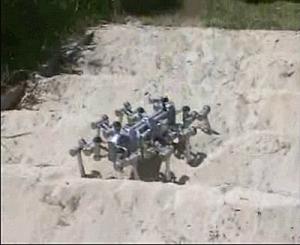Is any unmanned spacecraft a robotic probe? You might think so, given the tasks the hardware has to perform to accomplish a given scientific mission, but a more precise definition came out of the European Space Agency’s ASTRA 2004 workshop, held in the Netherlands early in November. Says Gianfranco Visentin, head of ESA’s Automation and Robotics Section, a space robot is “…a system having mobility and the ability to manipulate objects plus the flexibility to perform any combination of these tasks autonomously or by remote control.”
And according to this ESA press release, spacecraft robotics should be able to achieve the following:
We’re gaining a lot of experience with robots through the use of machines like NASA’s Mars rovers Spirit and Opportunity, which continue to set records for longevity and scientific discovery on the Red Planet. ESA’s own Aramies/Scorpion robot is an eight-legged rover that may go NASA one better, by providing a range of motion that can help it operate in extremely rugged terrain.
 But the problems faced by all space robotics are amplified hugely when we start talking about the long time frames demanded of interstellar missions. Even a forty-year journey to the Oort Cloud, which is about as far as we can reasonably extrapolate a mission we could design in the near future, would involve issues like radiation, which can cause errant behavior in electronic systems, even those specifically hardened for the environment. Thermal conditions test the mettle of any spacecraft, and communications delays make increasing autonomy essential. A probe in orbit around Centauri A would face an 8.6 year round-trip communications delay; autonomy thus becomes the sine qua non of any true interstellar attempt.
But the problems faced by all space robotics are amplified hugely when we start talking about the long time frames demanded of interstellar missions. Even a forty-year journey to the Oort Cloud, which is about as far as we can reasonably extrapolate a mission we could design in the near future, would involve issues like radiation, which can cause errant behavior in electronic systems, even those specifically hardened for the environment. Thermal conditions test the mettle of any spacecraft, and communications delays make increasing autonomy essential. A probe in orbit around Centauri A would face an 8.6 year round-trip communications delay; autonomy thus becomes the sine qua non of any true interstellar attempt.
Image: The Aramies/Scorpion robot is being developed for ESA by the University of Bremen. Credit: University of Bremen
“We are continuing,” says Visentin, “to do research into new types of robots which can cope with the special conditions in space, go where humans cannot and help astronauts manage the huge amount of work on the International Space Station.” All of which needs to be supplemented in the area of long-life electronics, redundancy, radiation hardening and artificial intelligence, a huge wish list that, just as much as the propulsion conundrum, could make interstellar robotic probes the driver for advances across the technological spectrum.


Review: Robots in Space
—
For decades people in the space community have argued the various
merits of human versus robotic spaceflight. Jeff Foust reviews a new
book that reexamines those issues and proposes a new paradigm for
space exploration.
http://www.thespacereview.com/article/1060/1
Hi ljk;
With the ever increasing computational speed of today’s computers, better parallel processing schemes, larger bytes, and even research into the virtually unlimited future computational power of quantum computers in terms of various computational formats and types, one imagines if there will come a day when computers will surpass us and perhaps any ETI beings in simulated intellegence and creativity.
Boolean logic tells us that there is no strickly logical or reasoning application based on systematic logic and mathematical algorithms that humans are capable which cannot in theory be duplicated by computers. Will these machines eventually develope souls, consciousness, sentient awareness such as perhaps has developed in humans and animals by evolutionary means involving the constituent biological machines. Might these future computers become complex enough so that any all powerful God would create and infuse them with a spiritual, immortal, rational, and free soul as Catholic Theologians argue that God has done for the human body. I do not mean to talk religion here, but these are some of the issues we are going to have to face as our computers become more complex and with such occuring, our robots also.
Thanks;
Jim
June 27, 2009
Spirit Rover Begins Making Night Sky Observations
Written by Nancy Atkinson
Spirit’s night observations from sol 1943. The bright streak is the star Canopus. Credit: NASA/JPL
When your rover has abundant energy but can’t go anywhere, what’s a scientist to do? How about making observations of the evening and night skies on Mars? With the benefit of a boost in electrical power from a wind gust cleaning off her solar panels, the Spirit rover has more energy available than she’s had for a couple of years. But unfortunately, Spirit is stuck in a patch of loose soil in the Home Plate region on Mars.
While the engineers at JPL work hard at figuring out how to “Free Spirit” (see the new website dedicated to their efforts) scientists are making observations of her surroundings to aid in the effort to get her out. But there’s also enough power to do additional observations, and astronomy was a logical choice.
“Certainly, a month or more ago, no one was considering astronomy with the rovers,” said Mark Lemmon, planetary scientist at Texas A&M University and member of the rover team.
“We thought that was done. With the dust cleanings, though, everyone thinks it is better to use the new found energy on night time science than to just burn it with heaters.” Besides, Lemmon added, using all the energy in the daytime might lead to overheating.
The image above was taken on Spirit’s sol 1943 (June 22 on Earth)showing the night sky above her location.
Full article and images here:
http://www.universetoday.com/2009/06/27/spirit-rover-begins-making-night-sky-observations/